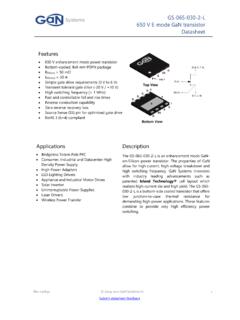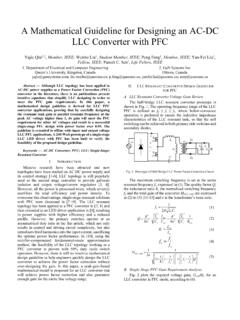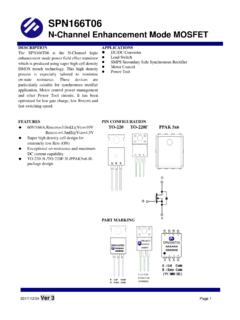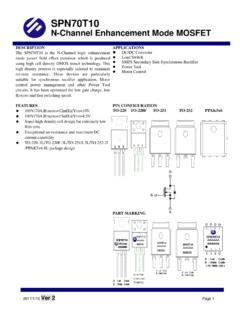Transcription of GN001 Application Guide Design with GaN Enhancement …
1 GaN Systems 1GN001 Application GuideDesign with GaN Enhancement mode HEMTU pdated on FEB 28, 2018 GaN Systems Systems 2 AgendaThis revision: Feb 28, 2018 Please visit the latest version of this document Basics Gate Drive Design considerations Design examples PCB Layout Switching Testing resultsGaN Systems 3 Fundamentals of a GaN HEMTGaN Enhancement mode High Electron Mobility Transistor (E-HEMT) A lateral 2-dimensional electron gas (2 DEG) channel formed on AlGaN/GaN hetero-epitaxy structure provides very high charge density and mobility For Enhancement mode operation, a gate is implemented to deplete the 2 DEG underneath at 0V or negative bias. A positive gate bias turns on the 2 DEG channel It works just like MOSFET except better switching performanceIDSvs. VDScharacteristics0204060801001201401601 8020005101520 VGS= 2 VVGS= 3 VVGS= 4 VVGS= 5 VVGS= 6 VIDS(A)VDS(V)Si substrate2 DEG ChannelSourceSubstrateGaN Buffer LayersAlGaN Barrier LayerGateDrainP-GaN0V+-VDSSi substrate2 DEG ChannelSourceSubstrateGaN Buffer LayersAlGaN Barrier LayerGateDrain+-VDS+P-GaNGaN Systems 4E-HEMT Gate characteristicsGate Bias LevelGaN Systems GaN E-HEMTSi MOSFETIGBTSIC MOSFETM aximum rating-10/+7V+/-20V+/-20V-8/+20 VTypical gate bias values0 or-3/+5-6V0/+10-12V0 or -9/+15V-4/+15-20 VCommon with Si MOSFET True E-mode, normally off Voltage driven -driver charges/discharges CISS Supply Gate leakage IGSS only Easy slew rate control by RGDifferences Much Lower QG: Lower drive loss; faster switching Higher gain and lower VGS: +5-6V gate bias to turn on Lower VG(th): typ.
2 Other e-mode GaN More robust gate: +7/-10V DC max rating No DC gate holding current required No complicated gate diode / PN junctionRG,extCGDCGSRG,intCDSGateDrainSo urceCISS= CGD+CGSGaN Systems 5 Reverse Conduction CharacteristicsVTH+VGS(OFF)GaN Reverse I/V CurveRDS(ON)ABCRDS(ON)RDS(REV)GaN E-HEMTMOSFETSi IGBTABCGateONONOFF No body diode but2 DEGcanconductin 3rdquadrant No need for anti-parallel diode When gate is OFF (during dead time) 2 DEGexhibits like a diode withVF= Vth+ VGS(off) Reduce dead time loss: 1) minimize dead time; 2) Use smaller or avoid negative VGSif possible GaN Systems 6 Reverse recovery performanceGaN EON= 92 JReverse Recovery charge QRR: GaN has zero QRRmaking it suitable for half bridge hard switching Replace IGBT Si MOSFET can t be used for any half bridge hard-switch circuit due to QRR Excellent reverse recovery of GaN enables new topologies such as bridgeless totem pole PFCVDSVGS DMath: VDS* DHalfbridgeturn-on400V/20A GaN E-HEMTHalf bridge turn-on 400V/20A SJ MOSFETSi MOSFET QRRLoss = 6670uJ!
3 Snappy recovery dIRR/dt, parasitic diode ruggedness QossLoss lower turn-on snappy recovery and uncontrolled high waveformsGaN Systems 7 Setting up dead timeVGSHVGSL For hard switching: td_pwmmust be > tdelay_skew+ (td(off)- td(on)): Gate turn-on/off delay difference varies with RG: typical +/-5ns range (GS66508) High/low side gate driver delay skew (worst case delay mismatch) usually dominates: Example SilabSi8261 isolated gate driver tdelay_skew_max= 25ns. In this case the dead time must be set > 30nsas minimum However in practical circuit safety margin must be considered: for GS66508 typical 50-100nsis chosen for dead time For soft switching dead time needs to be chosen for achieving ZVS transition For 100V: smaller can be used (10-20NS) as 100V driver has better delay matching Actual dead time Td_actual ~= td_pwm - tdelay_skew - td(off) + td(on)PWM signal dead time td_pwmVGS_Q1 VGS_Q2 VDStd(off)td(on)trGaN Systems 8 Agenda Basics Gate Drive Design considerations Design examples PCB Layout Switching Testing resultsGaN Systems 9 Design Considerations fast switchingGaN switches faster than Si/SiCMOSFETs with dv/dt> 100V/ns VGSGaN E-HEMT GS66508T (650V/50m )Cree SiC C3M006509D (900V/65m )Vgs=12V/-3V (SiC)Vgs=6V/-3V (GaN E-HEMT)VDS= (90V/ns)17ns (18V/ns)Double Pulse Test Hard Switch Turn-on (VDS=400V, ID=15A, RG(ON)=10 ) GaN has a 4x faster turn-on and ~2x faster off time than state of art SiC MOSFET with similar Rds(on)VDS=400 VGaN E-HEMTSiCVgs=12V/-3V (SiC)Vgs=6V/-3V (GaN E-HEMT)Hard Switching Turn-off (VDS = 400V, ID = 15A, RG(OFF)=1 )
4 Systems 10 Design Considerations Design considerations for driving high speed GaN E-HEMTs:Controlling noise coupling from power to gate drive loop should be the first priority: High dv/dtand di/dtcombined with low CISSand VG(th) Need to protect gate spikes from going above threshold or maximum rating under miller effect for safe operation Gate ringing or sustained oscillation may occur if the Design is not done properly and may lead to device failure. We will discuss how to mitigate that in this section On the other hand, the switching performance of GaN should not be compromised too much This is more critical for 650V hard switching half bridge Application as very high dv/dtcould occur at hard turn-on. Single end topology has less concern with miller effect, and for resonant ZVS topology the dv/dtand di/dtare lower so their Design requirement may be relaxed. In this section we will walk through the Design tips on how to control miller effect and mitigate gate ringing/oscillation, followed by gate driver recommendationsGaN Systems 11 Gate drive impedance (Rgand Lg) is critical for turn-off, but less at turn-onBasic rule: the gate needs to be held down as strong as possible with minimum impedanceMiller effect is more prominent at 650V than 100V Design due to the higher dv/dtControl miller effectCGDCDSCGSRGLGLDLCSLS imillerROLVDSVGSP ositive dv/dt Prevent false turn-on Strong pull-down (low RG/ROL) Low LGto avoid ringing Use negative gate bias, -2 to -3V is recommendedNegative dv/dtCGDCDSCGSRGLGLDLCSLS imillerROLVDSVGSVGS-_pkVGS+_pk Occurs at turn-on of the complementary switch in half bridge Keep VGS-_pkwithin -10V Strong pull-down (low RG/ROL) and low LG for lower ringing VGSmay bounce back >0V (LC ringing).
5 Ensure VGS+_pk< VG(TH) to avoid false turn-on or gate oscillation GaN Systems 12 Control miller effect For negative dv/dt, it is important to have a low-Z path for the reverse miller current to reduce the negative VGSspike (and the ringing afterwards caused by LC resonance) Pay attention to the VGS spike around VDS <50V due to the change of non-linear CISS/CRSS ratio A clamping diode is recommended for gate drive with single output. For gate drive with separate sink output the diode may not be needed depending on the RGand LGin the circuit For bipolar gate bias, use a TVS diode in series with the clamping diode (or two back to back) CGS may not help in some cases, be careful! ( induce LC resonance with Lgateand LCS) Negative gate bias can help to prevent false turn-on, but ensure worst case Vgs-_pkwithin -10 VVGS-3V6 VVDS-7 VHigh dv/dtwhen the other switch is being turned on<0 VRON=20 with DCLAMPRON=20 , no DCLAMP-13V -2V VO+RGONRGOFFGate DriverGDSVEEVO-VDD-3V+6 VDZ13V3D2 VORGONRGOFFD1 Gate DriverGNDD clampCGDCGSLCS0 VGaN Systems 13 Control miller effectSelect right gate resistor GaN E-HEMT speed can be easily controlled by gate resistors Critical to choose the right RG(ON)/RG(OFF)ratio for performance and drive stability Separate RGfor turn-on and off is recommended Recommend RG(ON)/RG(OFF) 5-10ratio for controlling the miller effect GaN has extremely low Qgand drive loss: most cases 0402/0603 SMD resistors can be used Turn on RG(ON): Control the turn-on dv/dtslew rate Too high RG(ON)slows down switching and increases loss Too small RGON.
6 High dv/dt-> Higher switching loss due to the miller turn-on and potential gate oscillation For GS66508: recommend to start with RG(ON) = 10-20 Turn off RG(OFF): Typical starting value range is 1-2 Provide strong and fast pull-down for robust gate driveVORGONRGOFFD1 Low Vf Schottky DiodeGate DriverGDSGNDVO+RGONRGOFFGate DriverGDSGNDVO-Gate driver w/ single outputGate driver w/ separate outputs(Preferred) GaN Systems 14 Mitigate gate ringing/oscillationsWhat causes the gate ringing/oscillation? Gate over/undershoot and ringing caused by high LG Common Source Inductance LCS Feedback path from power to gate loop (di/dt) Capacitive coupling via miller capacitor CGD (dv/dt) Noise coupling via test probeWhat to do if gate ringing/oscillation occurs? First improve the layout by reducing LG, LCSand external G-D coupling: Locate driver as close to gate as possible Low inductance wide PCB trace and polygon Use kelvin source connection to minimize LCS Select right RGto tune turn-on slew rate Try negative gate bias (-3V) for turn-off At last resort try circuits below to damp the high frequency LC ringing & overshoot: Use a ferrite bead with Z=10-20 @100 MHzin series with gate.
7 (ferrite bead may increase LGbut damp the high frequency gate current ringing) RC snubber across G-S: example R= CGDCGSRGLGLDLCSLSRG1 LCSFB1Z= Systems 15 High side driver considerations GaN enables fast switching dv/dt>100kV/us: Minimize Coupling capacitance CIO CM current via CIOlimits CMTI Use isolator/isolated gate driver with high CMTI Full Isolated gate drive: Best performance Isolation power supply Minimize inter-winding Capacitance Bootstrap: Common for lower voltage 100V half bridge Design Lower cost and simpler circuit Choose the bootstrap diode with low CJand fast recovery time. Watch for bootstrap diode power loss limit and recovery time for high-frequency operation. Post-regulation or voltage clamping may be required after bootstrapHigh side gate driveIsolatorPWMDGSI solated DC/DCGate DriverRG_ONRG_OFFVCC0V0 VGDHVCM0 VICMHigh side floating ground VCMCIOCIOICMICMI solated DC/DCVCCHigh side floating groundCIOICMO ptional common mode choke at input side to suppress CM noiseGaN Systems 16 Bootstrap circuit Good for low cost 0-6V gate drive What is the problem with traditional bootstrap circuit?
8 GaN E-HEMT requires good regulation of gate bias (5-6V bias, max rating 7V) LS free wheeling: Switch node negative voltage overcharges bootstrap capacitors (VGS>7V) HS free wheeling: Bootstrap diode voltage drops reduces VGSbelow 6V Post-regulation or voltage clamping to ensure high side bias is tightly regulated to 6 VBootstrap with post-regulation using +9V for regulated high side bias+9V0 VDB1+ +9V0 VDB1+ DriverRG_ONRG_OFFDGSQ2 Gate DriverRG_ONRG_OFF+6V0 VIsolatorDBS0 VGDHCBOOT0 VGDHPWM_HVDRVHPWM_LVBUS+GND-2 ~ +-VSDCan be over-charged to 7-9 VBootstrap for Sync Buck (only need to clamp overcharge, example 100V sync buck)+ Zener diode to clamp to 6 VUse LDO to regulate to 6 VUse Zener diodeGaN Systems 17 ConfigurationsGate Driver/Controller ICDesign resources650V Half/Full : LLC, PSFB, Sync : Totem pole PFC, Active Clamp , motor driveSi8271 Single;Si8273/4/5 HB/Dual-GB (0-6V) or AB (-3/+6V)Si827x DatasheetSi8271 demo board (GS66508T)IMS evaluation board User GuideADuM4121 ARIZ(0-6V Drive)ADuM4121 BRIZ(-3/+6V Drive)ADuM4121 DatasheetACPL-P346 Use -4/+6V gate driveACPL-P346 DatasheetACPL-P346 Evaluation Board with GS66508T80-100V Half/Full D Power TransferLM5113(NRND): 100V, max 5 MHzLMG1205: 80V/5A HB DriverLM5113 DatasheetLMG1205 DatasheetPE29101:100V,48V DC/DC,33 MHzPE29102: 60V, Class D Audio, WPT, 40 MHzPE29100 DatasheetPE20102 DatasheetPE29102 Demo board (GS61004B)UPI Semi GaN FET drivers:uP1966A.
9 Dual-Channel GaN driveruP1966A GaN DriverUltra High Speed 80V HB Driver for GaN ApplicationRecommended GaN driver/controller ICsThe following drivers have been verified by GaN Systems and are recommended for use with our GaN E-H E M Ts GaN Systems 18 Recommended GaN driver/controller ICsConfigurationsGate Driver/Controller ICDesign resourcesLow side non-isolated driver for 650V/100V GaN* , E P/ALM5114/UCC27511: Single Channel, 4A, 5-6V driveUCC27611: w/ internal LDO (5V)LM5114 DatasheetUCC2751x DatasheetuP1964:Internal LDO for 6V driveuP1964 DatasheetOther GaN compatible drivers IXD609SI: Single, 6V drive, high drive current (9A)FAN3122/TC4422: Single, 6V drive, high drive current (9A)FAN3223/4/5: Dual 4A, 6V drive, for push-pull or SR applicationSync Buck DC/DC (100V GaN):1. 48V-12V DC/DCLTC7800: 60V, Sync. Step-Down Controller (up to , w/ integrated GaN compatible drivers)LTC7800 DatasheetSecondary side Rectification (100V GaN) frequency : 5V gate drive clamp, 1 MHz maxNCP4305 DatasheetSRK2001: Adaptive SR controller for LLC, 5-6V drive for GaN, 500 KHz maxSRK2001 Datasheet[*] Low side non-isolated drivers can also be used on high side / half bridge configurations by combining with level-shift / signal isolators, see page 29for Design Systems 19 Agenda Basics Gate Drive Design considerations Design examples PCB Layout Switching Testing resultsGaN Systems 20650V Isolated Driver Design #1 0-6V driveSi8271-based isolated driver (0-6V drive)VDD: 5/9 or 12V depending on system power railOptional CM Choke for better noise immunity against dv/dtChoose isolated DC/DC PS1: 5/9/12V to 9V, 1W, 3kV isolation Low CIOpreferred for dv/dtimmunity Verified/Recommended P/N: RECOM R1S-xx09/HP MornsunFxx09XT-1WR2 PWM Input.
10 Or5V logic from controller Optional RC filter for noise filtering Consider driver w/ deglitcher(-IS1 suffix) for noisy environment6V LDO for tight VDRV regulationEnable: Direct tie to VDDI if not used Recommend filter cap (100nF) close to EN pin to prevent false triggering IsolationGate RGATER2: typ. 10-20 RGATER3: typ. 1-2 Keep this loop routing as tight as possible Recommended for high-frequency ZVS applicationGaN Systems 21650V Isolated Driver Design #2 bipolar driveSi8271-based isolated gate driver (-3/+6V drive) Lower risk of cross-conduction and gate oscillation, faster turn-off (lower switching loss) Higher reverse conduction loss Recommended for hard-switching or high power applicationsDZ1 and R2 divide 9V into -6V and +3v gate bias. The mid-point is used as a ground 0V which should be connected to the SS of GaN device Place bypass cap C7/C8 close to U1 VDD/GND Keep loop between U1 and Q1 Gate/SS as tight as possible Higher UVLO driver can be usedGaN Systems 22 Bootstrap Half bridge gate driver Use fast recov











